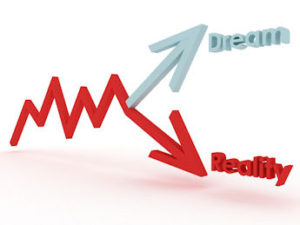by Rhode Warrior Blogger, Mark Noll

Before I began my career in Prospect Research / Advancement Services, a field I’ve been in now for over 17 years, I spent many years working in Employment and Training. As I expanded my current professional scope to include the area of data analysis, I could not help but look at the data both from a prospect researcher’s perspective as well as that of a labor market analyzer.
My two professional worlds have collided at a crossroads and have resulted in a somewhat disconcerting view of the future of fundraising. What follows is an analysis of this collision. You may or may not agree with what I have to say, but my experience tells me it is something that should not be disregarded outright.
Is the recession truly over?
Over the years we have all lost donors for reasons unknown. The list of possibilities is endless. But the most recent recession, a recession that some economists say is over, appears to me to be a game-changer in terms of lost donors. Many post-recession surveys show that donors are still giving but on the average they have cut back on the number of charities to which they donate. This likely translates into a decrease in overall annual giving.
Have those donors that cut back on giving returned to their pre-recession giving? My feeling is that in many cases they have not. Nor will they be returning any time soon. For you see, the occasional lower to middle-end annual fund donor, that one who gave only when asked or only when circumstances were right, may be gone forever.
Oh, you’re so negative Mark! I get that often and deservingly so, but in this case, I don’t think I’m being unrealistic. The recession that started in December of 2007 changed Middle America and hence the donor dynamic. This time around, for some, the great American dream became simply that – a dream.
Middle America’s Dream
Middle America for years has a found a way to live the American Dream despite stagnant wages and downsizing. The “Leave it to Beaver” image of prosperity, that is to say, Dad working and Mom stays at home, was the result of a post-war economic boom where America saw an increase in jobs, productivity and wages that lasted for many years. But as the cost of living rose disproportionately to wages over the following years, the dream became compromised.
No longer could Dad support the household alone. As a result, the difference was offset by their spouses entering the workforce. The double income afforded many to maintain their lifestyle. Then as the wages of the double income families were offset over the years by layoffs, plant closings and/or wage stagnation, Americans turned toward their last lifeline to maintain the American Dream – easy credit. And then around 2008, the credit bubble burst and the great recession began.
Why was it the “great recession?”
Unlike past recessions, this time the jobs that were lost are likely not coming back as they had previously. The idea of Unemployment Insurance years ago was to tide someone over between the time they were laid off and subsequently called back to their original job. That is no longer the norm. The data further shows that many people who have lost their jobs either have not found new work or have taken jobs at a lesser salary. The return to previous economic conditions has not happened.
So here we stand in the post-recession era as fundraisers. Our top donors are still giving and sometimes in vast amounts. As the scales of wealth have tilted towards those with the means to invest, those investments have paid tidy returns. These high-wealth individuals are still our best donors and friends. However, those who were impacted by the great recession have had to make cuts to make ends meet and the first place they likely looked was at charitable giving.
Oddly, many of us are looking at our donor databases and see that Mr. and Mrs. Jones stopped giving in 2010. Worst of all, they are SYBUNTS and we have the audacity to call them and wonder why they stopped giving and ask for another denotation. Talk to your phonathon callers, I’m sure they’ve heard a few stories.
With the changing tide, maybe we need to rethink how we approach annual giving prospects. Capacity at the “average Joe” level might best be viewed from the perspective of liquidity instead of assets since assets now may be trumped by existing debt. The tried and true recency-frequency-monetary mantra may need to be examined more thoroughly if any of the factors show a negative result. The gap may be saying something more than “not this year.” It may well be an indicator of changing economic times.
Overall, giving continues to rise but that’s more a result of fewer people giving more dollars. And this is no statistical fluke. This could very well be the new reality. The targeting of fewer donors with the most means may very well be the new order. The decline in donors is not the result of lost affinity but rather the lack of means to support that affinity.
The socio-economic structure that has evolved from the most recent recession will likely make us rethink our traditional strategies of fundraising. Many institutions probably see this trend already. But I would caution anyone who thinks this is a temporary result of the most recent recession rather than the emergence of the new American culture of philanthropy.
Related Articles
- How a Two-Tier Economiy is Reshaping the Marketplace (The Wall Street Journal, 1/28/2015)
- As Wealthy Give Smaller Share of Income to Charity, Middle Class Digs Deeper (Chronicle of Philanthropy, 10/5/2014)
- To those that have shall be given: Labour is steadily losing out to capital, from Special Report: World Economy (The Economist, 10/4/2014)

